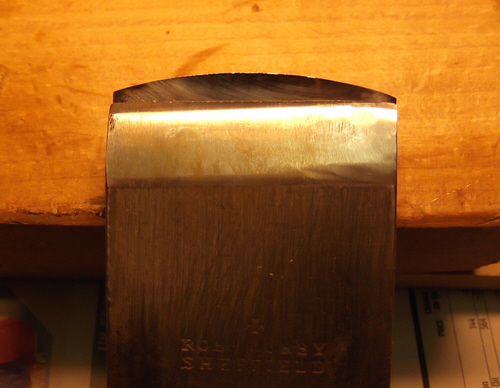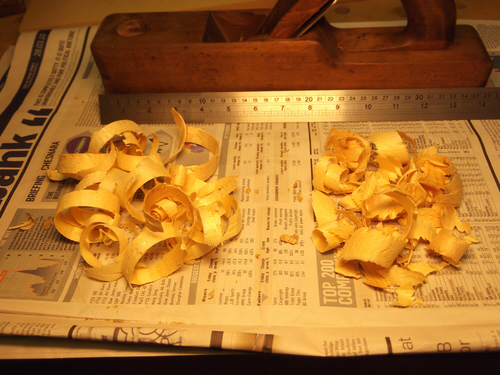Hi all,
I recently posted a question (here: http://www.ukworkshop.co.uk/forums/post666408.html#p666408, in a general discussion about scrub planes), asking about mouth shape in a conversion I was contemplating. I've now started the conversion, but before committing further effort I would dearly love a sanity check from those who have first hand knowledge (I have never used, nor even handled, such a plane before, so I am unsure what to expect by way of performance).
First a picture of the plane I'm starting with : a 14" razee jack with a double iron; the iron is 1.75" wide and Robert Sorby cutting iron is 4mm thick at the bevel end. You can see why I called it "knackered" in the previous thread - the tote is chipped and loose, the strike button is missing (though leaving a nice hole for a future front knob ), and there are some cracks in the body (nothing too serious).
), and there are some cracks in the body (nothing too serious).

So far, I have concentrated on shaping the cutting iron and the mouth. I put a 90mm radius arc on the cutter, then rough ground the bevel to 25 degrees by eye, finishing with flattening the back and honing a 30 degree final bevel using a WorkSharp and a simple jig. The mouth I opened with a chisel and rasp (still rough and unfinioshed, but large enough for this test I believe). See the next two pictures:


The cap-iron is well out of square (see next photo), but I suspect this doesn't matter too much for the intended use - I'm assuming a 4mm-thick cutting iron should be enough, without support to the very tip from the cap iron. Is that right, do you think?

Now (at last!... I hear you say) for the sanity check ...
...
With about 1" width of blade, projecting a tad less than 1mm through the mouth, I tried reducing two boards both in width and thickness. One was a badly cupped 'pine' board (6" wide x 1" x 36" long) - not really 'pine', just some sort of cheap B&Q-type softwood. The other was a smaller piece of engineered oak shelving (5" wide x 1.25" x 9" long), which was flat and square to start with.
The two photos below show the chips/shavings produced from the two types of wood.
First, the softwood. This felt OK, generally. Planing along the narrow edge to reduce it in width produced longish shavings about 0.9mm thick (pile on the left in the picture). Planing diagonally across the width to reduce the thickness produced the pile on the right - same thickness, shorter shavings (more like 'chips') : generally felt OK but with some tendency to tear out lumps, particularly near knots.

Then the oak. This didn't feel at all good. Planing along the narrow edge to reduce it in width didn't produce shavings - more like curly chips (see pile on the left). Same thickness as before. It worked, but it wasn't a nice experience. Diagonally across the width produced even smaller chips (pile of the right), and again the tendency to tear bits out of the wood rather than to cut it (no knots in this board) - definitely felt more like gouging than planing - not something I would care to try on anything except scrap wood.

So, to the question: is this about what you would expect? If not, can you tell from the pictures and description I have been able to provide what I should be doing differently? Is the radius of the camber on the blade to great/aggressive? Retract the blade more on hardwood? Throw ii in the bin and buy a planer/thicknesser ?
?
I don't expect to have to use a scrub plane very often, so this project is being undertaken more in the spirit of experiment and self-education than of necessity; I'm therefore reluctant to expend more effort on this project (tote repair, adding knob, etc etc) if it's a non-runner. Any comments or advice you can offer would be very welcome.
Many thanks
Chris
I recently posted a question (here: http://www.ukworkshop.co.uk/forums/post666408.html#p666408, in a general discussion about scrub planes), asking about mouth shape in a conversion I was contemplating. I've now started the conversion, but before committing further effort I would dearly love a sanity check from those who have first hand knowledge (I have never used, nor even handled, such a plane before, so I am unsure what to expect by way of performance).
First a picture of the plane I'm starting with : a 14" razee jack with a double iron; the iron is 1.75" wide and Robert Sorby cutting iron is 4mm thick at the bevel end. You can see why I called it "knackered" in the previous thread - the tote is chipped and loose, the strike button is missing (though leaving a nice hole for a future front knob

So far, I have concentrated on shaping the cutting iron and the mouth. I put a 90mm radius arc on the cutter, then rough ground the bevel to 25 degrees by eye, finishing with flattening the back and honing a 30 degree final bevel using a WorkSharp and a simple jig. The mouth I opened with a chisel and rasp (still rough and unfinioshed, but large enough for this test I believe). See the next two pictures:


The cap-iron is well out of square (see next photo), but I suspect this doesn't matter too much for the intended use - I'm assuming a 4mm-thick cutting iron should be enough, without support to the very tip from the cap iron. Is that right, do you think?

Now (at last!... I hear you say) for the sanity check
With about 1" width of blade, projecting a tad less than 1mm through the mouth, I tried reducing two boards both in width and thickness. One was a badly cupped 'pine' board (6" wide x 1" x 36" long) - not really 'pine', just some sort of cheap B&Q-type softwood. The other was a smaller piece of engineered oak shelving (5" wide x 1.25" x 9" long), which was flat and square to start with.
The two photos below show the chips/shavings produced from the two types of wood.
First, the softwood. This felt OK, generally. Planing along the narrow edge to reduce it in width produced longish shavings about 0.9mm thick (pile on the left in the picture). Planing diagonally across the width to reduce the thickness produced the pile on the right - same thickness, shorter shavings (more like 'chips') : generally felt OK but with some tendency to tear out lumps, particularly near knots.

Then the oak. This didn't feel at all good. Planing along the narrow edge to reduce it in width didn't produce shavings - more like curly chips (see pile on the left). Same thickness as before. It worked, but it wasn't a nice experience. Diagonally across the width produced even smaller chips (pile of the right), and again the tendency to tear bits out of the wood rather than to cut it (no knots in this board) - definitely felt more like gouging than planing - not something I would care to try on anything except scrap wood.

So, to the question: is this about what you would expect? If not, can you tell from the pictures and description I have been able to provide what I should be doing differently? Is the radius of the camber on the blade to great/aggressive? Retract the blade more on hardwood? Throw ii in the bin and buy a planer/thicknesser
I don't expect to have to use a scrub plane very often, so this project is being undertaken more in the spirit of experiment and self-education than of necessity; I'm therefore reluctant to expend more effort on this project (tote repair, adding knob, etc etc) if it's a non-runner. Any comments or advice you can offer would be very welcome.
Many thanks
Chris











































